The Role of Training and Development in ASDA's Employee Performance
VerifiedAdded on 2022/12/28
|53
|9706
|81
Report
AI Summary
This research project examines the crucial role of training and development strategies in enhancing employee performance and contributing to business success, with a specific focus on ASDA. The report includes a detailed research proposal, literature review, methodology, data analysis, and conclusions. The research objectives include determining the importance of talent management, analyzing the role of training and development, exploring the complexities faced by ASDA in talent management, and identifying the measures taken by the company to manage talent. The methodology section describes the research philosophy, approaches, strategy, and data collection methods, including sampling techniques. The literature review explores the importance of talent management, the impact of training and development on employee performance, the complexities ASDA faces, and the measures the company takes to address these issues. The report also includes reflections on alternative research methodologies and provides recommendations for future research. The findings are presented in a PPT format, with the conclusion summarizing the key insights and recommendations for ASDA to improve its talent management and employee performance.
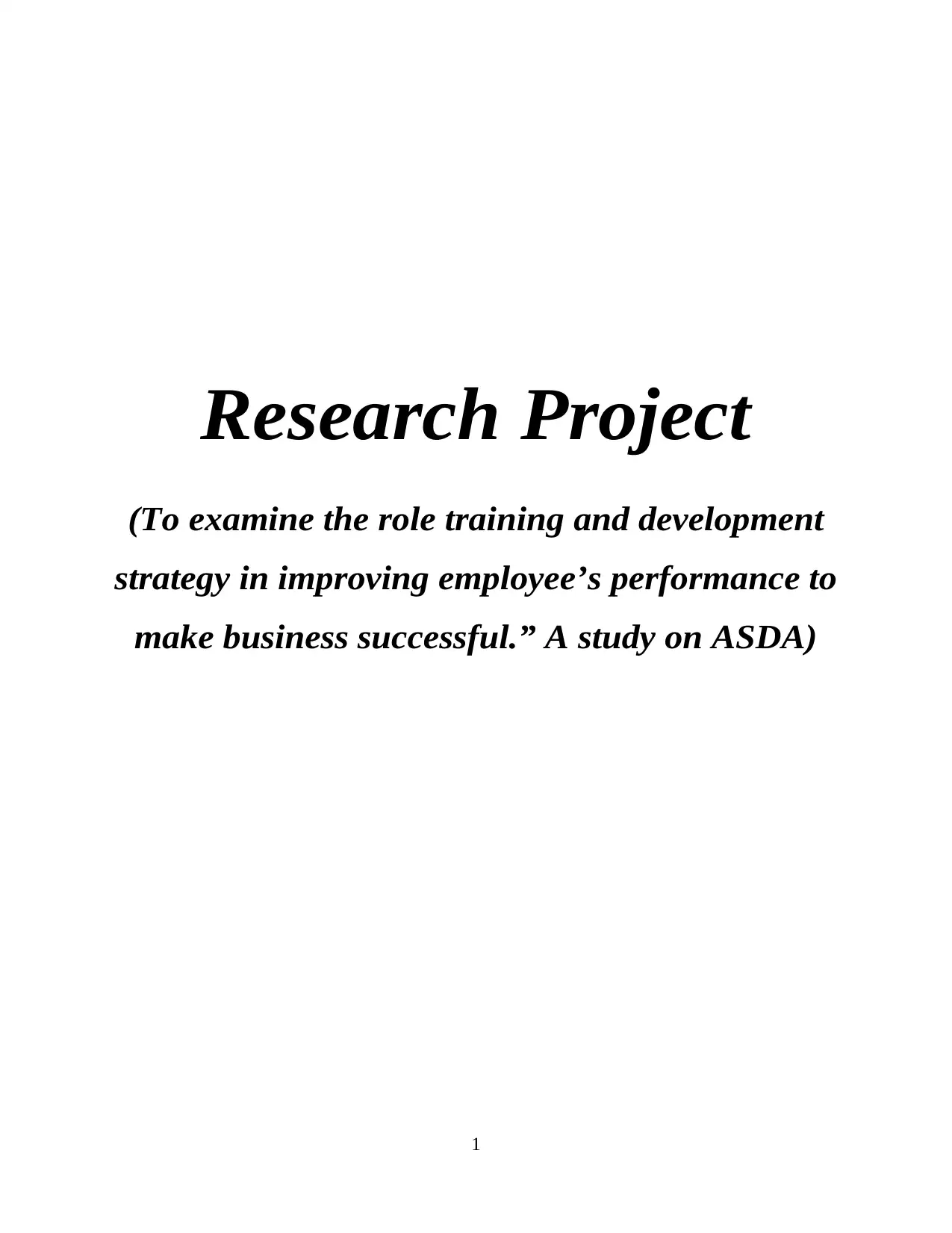
Research Project
(To examine the role training and development
strategy in improving employee’s performance to
make business successful.” A study on ASDA)
1
(To examine the role training and development
strategy in improving employee’s performance to
make business successful.” A study on ASDA)
1
Paraphrase This Document
Need a fresh take? Get an instant paraphrase of this document with our AI Paraphraser
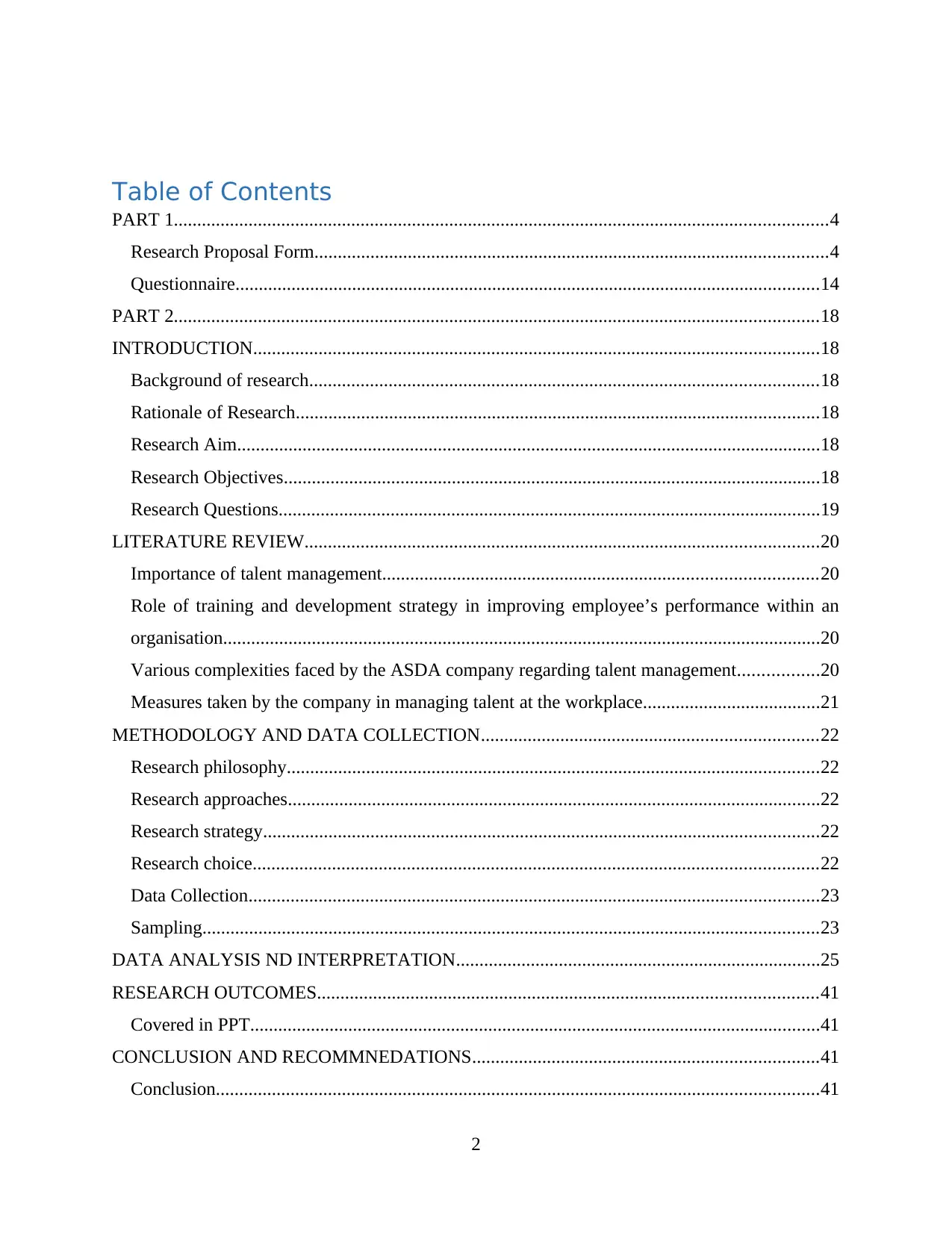
Table of Contents
PART 1............................................................................................................................................4
Research Proposal Form..............................................................................................................4
Questionnaire.............................................................................................................................14
PART 2..........................................................................................................................................18
INTRODUCTION.........................................................................................................................18
Background of research.............................................................................................................18
Rationale of Research................................................................................................................18
Research Aim.............................................................................................................................18
Research Objectives...................................................................................................................18
Research Questions....................................................................................................................19
LITERATURE REVIEW..............................................................................................................20
Importance of talent management.............................................................................................20
Role of training and development strategy in improving employee’s performance within an
organisation................................................................................................................................20
Various complexities faced by the ASDA company regarding talent management.................20
Measures taken by the company in managing talent at the workplace......................................21
METHODOLOGY AND DATA COLLECTION........................................................................22
Research philosophy..................................................................................................................22
Research approaches..................................................................................................................22
Research strategy.......................................................................................................................22
Research choice.........................................................................................................................22
Data Collection..........................................................................................................................23
Sampling....................................................................................................................................23
DATA ANALYSIS ND INTERPRETATION..............................................................................25
RESEARCH OUTCOMES...........................................................................................................41
Covered in PPT..........................................................................................................................41
CONCLUSION AND RECOMMNEDATIONS..........................................................................41
Conclusion.................................................................................................................................41
2
PART 1............................................................................................................................................4
Research Proposal Form..............................................................................................................4
Questionnaire.............................................................................................................................14
PART 2..........................................................................................................................................18
INTRODUCTION.........................................................................................................................18
Background of research.............................................................................................................18
Rationale of Research................................................................................................................18
Research Aim.............................................................................................................................18
Research Objectives...................................................................................................................18
Research Questions....................................................................................................................19
LITERATURE REVIEW..............................................................................................................20
Importance of talent management.............................................................................................20
Role of training and development strategy in improving employee’s performance within an
organisation................................................................................................................................20
Various complexities faced by the ASDA company regarding talent management.................20
Measures taken by the company in managing talent at the workplace......................................21
METHODOLOGY AND DATA COLLECTION........................................................................22
Research philosophy..................................................................................................................22
Research approaches..................................................................................................................22
Research strategy.......................................................................................................................22
Research choice.........................................................................................................................22
Data Collection..........................................................................................................................23
Sampling....................................................................................................................................23
DATA ANALYSIS ND INTERPRETATION..............................................................................25
RESEARCH OUTCOMES...........................................................................................................41
Covered in PPT..........................................................................................................................41
CONCLUSION AND RECOMMNEDATIONS..........................................................................41
Conclusion.................................................................................................................................41
2
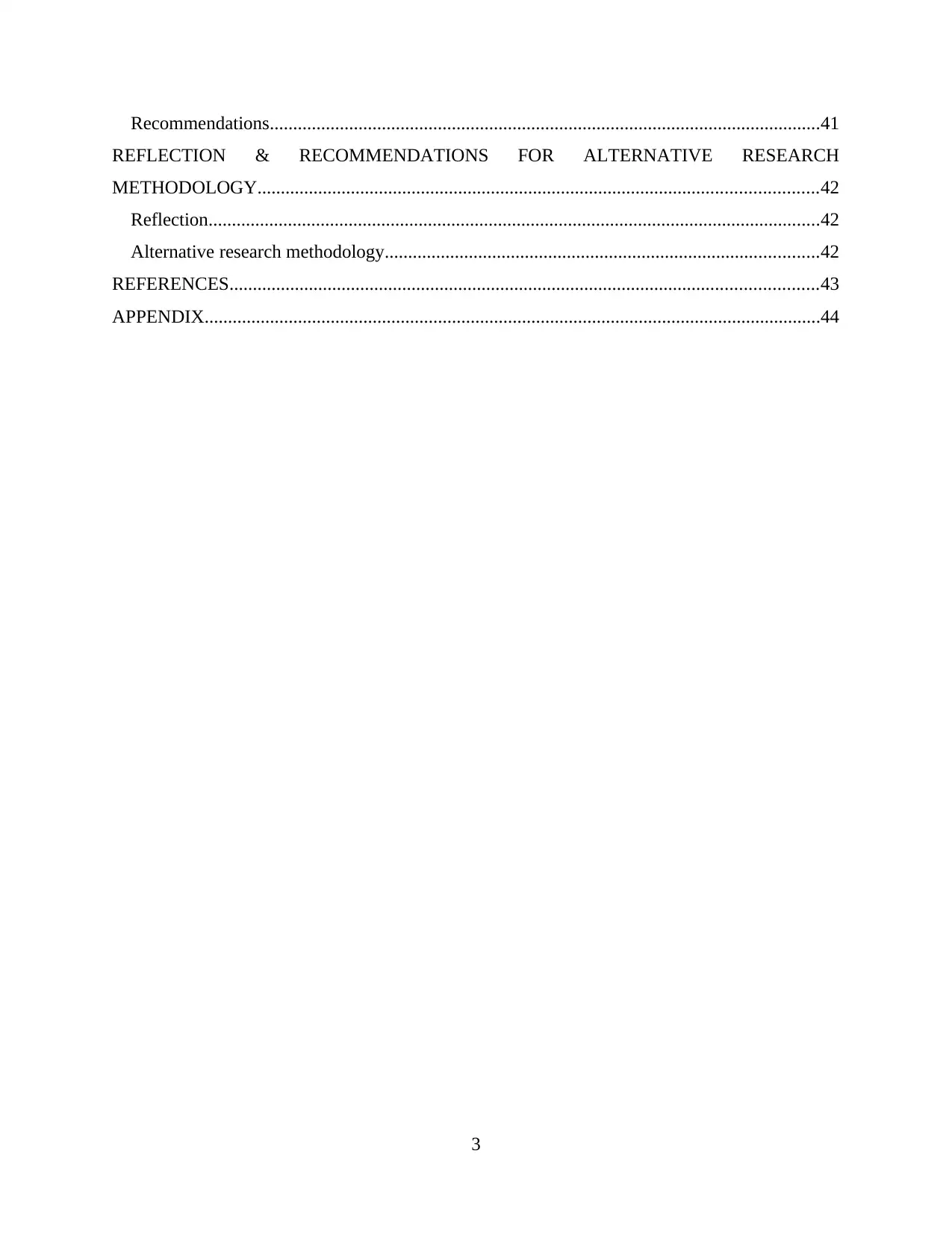
Recommendations......................................................................................................................41
REFLECTION & RECOMMENDATIONS FOR ALTERNATIVE RESEARCH
METHODOLOGY........................................................................................................................42
Reflection...................................................................................................................................42
Alternative research methodology.............................................................................................42
REFERENCES..............................................................................................................................43
APPENDIX....................................................................................................................................44
3
REFLECTION & RECOMMENDATIONS FOR ALTERNATIVE RESEARCH
METHODOLOGY........................................................................................................................42
Reflection...................................................................................................................................42
Alternative research methodology.............................................................................................42
REFERENCES..............................................................................................................................43
APPENDIX....................................................................................................................................44
3
⊘ This is a preview!⊘
Do you want full access?
Subscribe today to unlock all pages.

Trusted by 1+ million students worldwide
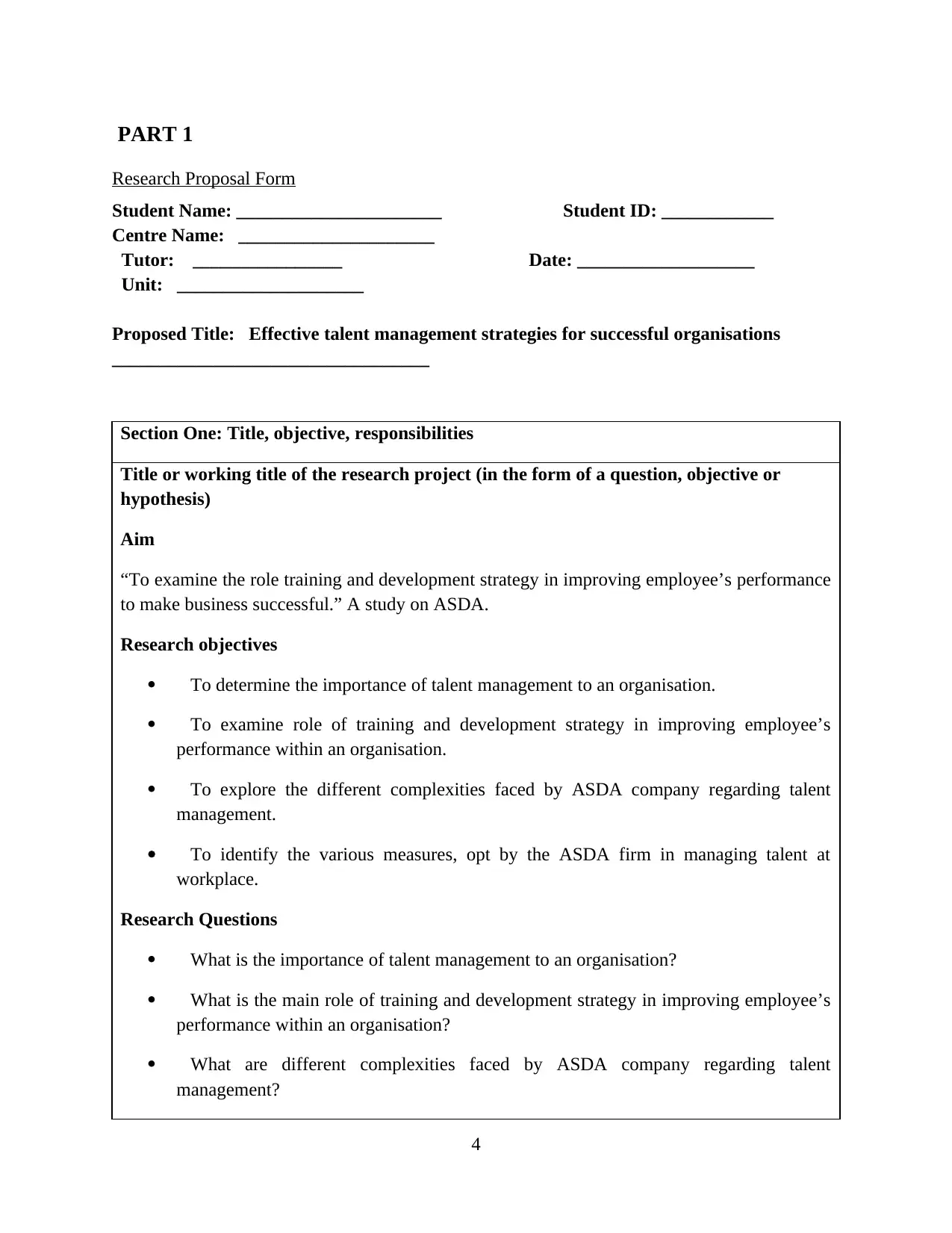
PART 1
Research Proposal Form
Student Name: ______________________ Student ID: ____________
Centre Name: _____________________
Tutor: ________________ Date: ___________________
Unit: ____________________
Proposed Title: Effective talent management strategies for successful organisations
__________________________________
Section One: Title, objective, responsibilities
Title or working title of the research project (in the form of a question, objective or
hypothesis)
Aim
“To examine the role training and development strategy in improving employee’s performance
to make business successful.” A study on ASDA.
Research objectives
To determine the importance of talent management to an organisation.
To examine role of training and development strategy in improving employee’s
performance within an organisation.
To explore the different complexities faced by ASDA company regarding talent
management.
To identify the various measures, opt by the ASDA firm in managing talent at
workplace.
Research Questions
What is the importance of talent management to an organisation?
What is the main role of training and development strategy in improving employee’s
performance within an organisation?
What are different complexities faced by ASDA company regarding talent
management?
4
Research Proposal Form
Student Name: ______________________ Student ID: ____________
Centre Name: _____________________
Tutor: ________________ Date: ___________________
Unit: ____________________
Proposed Title: Effective talent management strategies for successful organisations
__________________________________
Section One: Title, objective, responsibilities
Title or working title of the research project (in the form of a question, objective or
hypothesis)
Aim
“To examine the role training and development strategy in improving employee’s performance
to make business successful.” A study on ASDA.
Research objectives
To determine the importance of talent management to an organisation.
To examine role of training and development strategy in improving employee’s
performance within an organisation.
To explore the different complexities faced by ASDA company regarding talent
management.
To identify the various measures, opt by the ASDA firm in managing talent at
workplace.
Research Questions
What is the importance of talent management to an organisation?
What is the main role of training and development strategy in improving employee’s
performance within an organisation?
What are different complexities faced by ASDA company regarding talent
management?
4
Paraphrase This Document
Need a fresh take? Get an instant paraphrase of this document with our AI Paraphraser
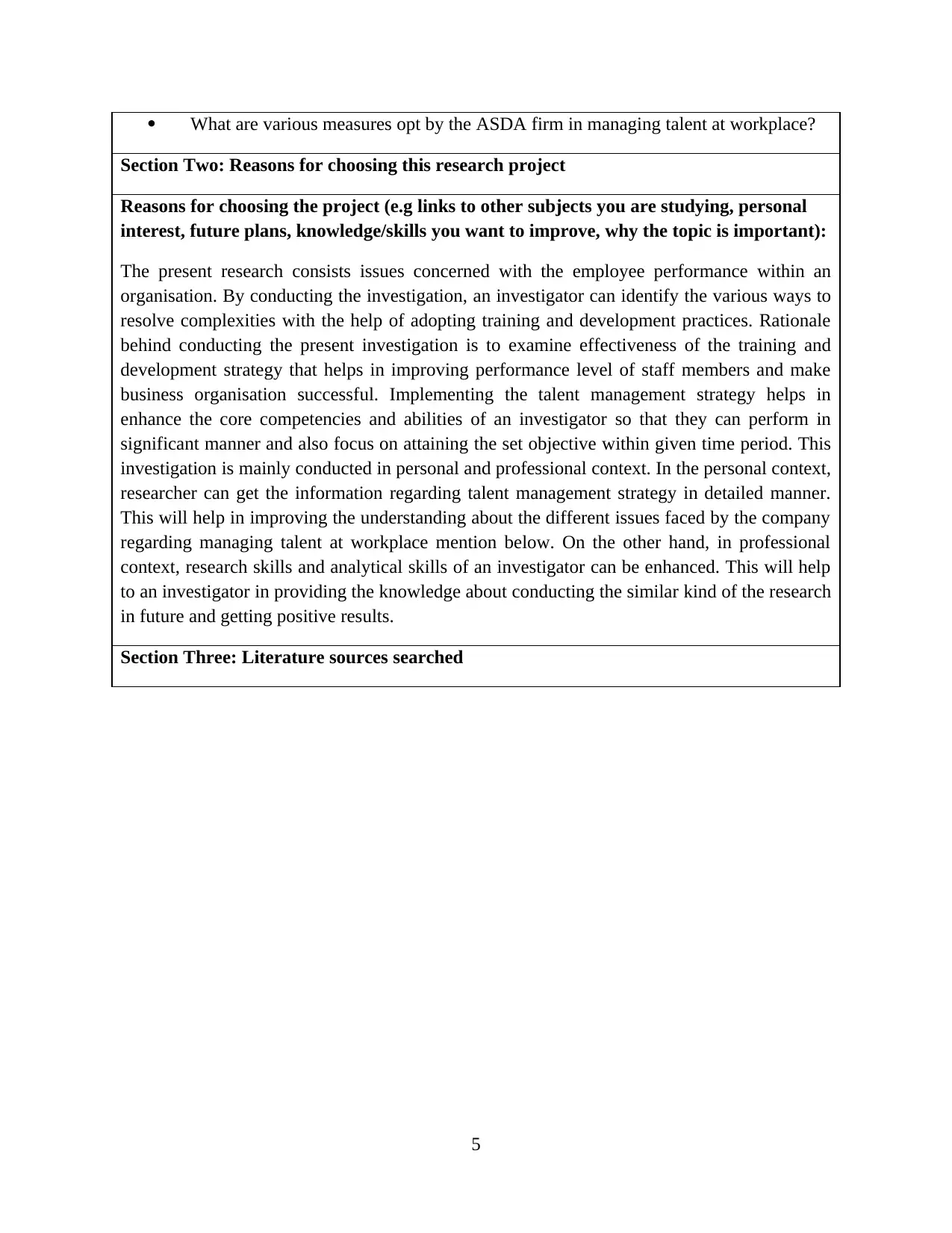
What are various measures opt by the ASDA firm in managing talent at workplace?
Section Two: Reasons for choosing this research project
Reasons for choosing the project (e.g links to other subjects you are studying, personal
interest, future plans, knowledge/skills you want to improve, why the topic is important):
The present research consists issues concerned with the employee performance within an
organisation. By conducting the investigation, an investigator can identify the various ways to
resolve complexities with the help of adopting training and development practices. Rationale
behind conducting the present investigation is to examine effectiveness of the training and
development strategy that helps in improving performance level of staff members and make
business organisation successful. Implementing the talent management strategy helps in
enhance the core competencies and abilities of an investigator so that they can perform in
significant manner and also focus on attaining the set objective within given time period. This
investigation is mainly conducted in personal and professional context. In the personal context,
researcher can get the information regarding talent management strategy in detailed manner.
This will help in improving the understanding about the different issues faced by the company
regarding managing talent at workplace mention below. On the other hand, in professional
context, research skills and analytical skills of an investigator can be enhanced. This will help
to an investigator in providing the knowledge about conducting the similar kind of the research
in future and getting positive results.
Section Three: Literature sources searched
5
Section Two: Reasons for choosing this research project
Reasons for choosing the project (e.g links to other subjects you are studying, personal
interest, future plans, knowledge/skills you want to improve, why the topic is important):
The present research consists issues concerned with the employee performance within an
organisation. By conducting the investigation, an investigator can identify the various ways to
resolve complexities with the help of adopting training and development practices. Rationale
behind conducting the present investigation is to examine effectiveness of the training and
development strategy that helps in improving performance level of staff members and make
business organisation successful. Implementing the talent management strategy helps in
enhance the core competencies and abilities of an investigator so that they can perform in
significant manner and also focus on attaining the set objective within given time period. This
investigation is mainly conducted in personal and professional context. In the personal context,
researcher can get the information regarding talent management strategy in detailed manner.
This will help in improving the understanding about the different issues faced by the company
regarding managing talent at workplace mention below. On the other hand, in professional
context, research skills and analytical skills of an investigator can be enhanced. This will help
to an investigator in providing the knowledge about conducting the similar kind of the research
in future and getting positive results.
Section Three: Literature sources searched
5
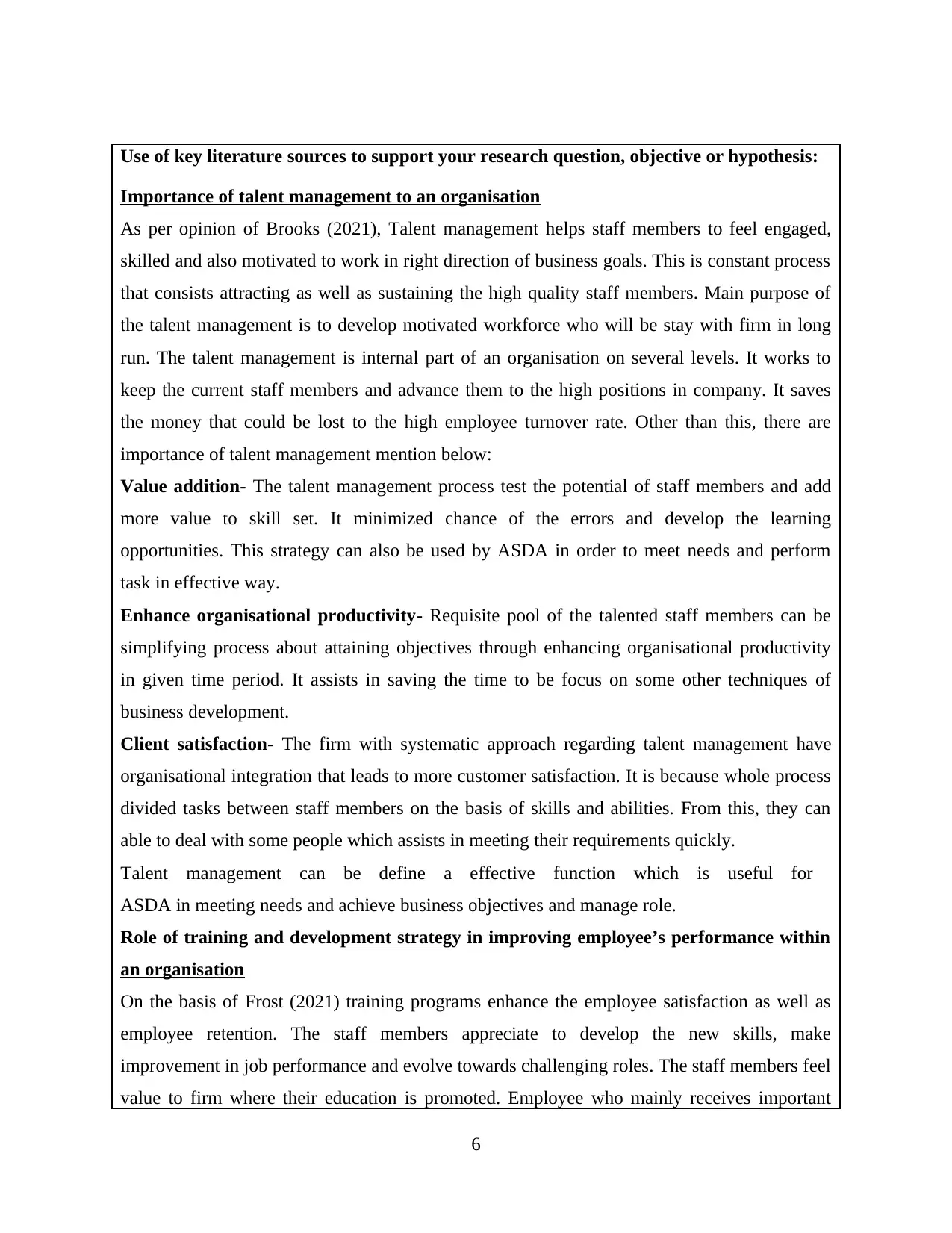
Use of key literature sources to support your research question, objective or hypothesis:
Importance of talent management to an organisation
As per opinion of Brooks (2021), Talent management helps staff members to feel engaged,
skilled and also motivated to work in right direction of business goals. This is constant process
that consists attracting as well as sustaining the high quality staff members. Main purpose of
the talent management is to develop motivated workforce who will be stay with firm in long
run. The talent management is internal part of an organisation on several levels. It works to
keep the current staff members and advance them to the high positions in company. It saves
the money that could be lost to the high employee turnover rate. Other than this, there are
importance of talent management mention below:
Value addition- The talent management process test the potential of staff members and add
more value to skill set. It minimized chance of the errors and develop the learning
opportunities. This strategy can also be used by ASDA in order to meet needs and perform
task in effective way.
Enhance organisational productivity- Requisite pool of the talented staff members can be
simplifying process about attaining objectives through enhancing organisational productivity
in given time period. It assists in saving the time to be focus on some other techniques of
business development.
Client satisfaction- The firm with systematic approach regarding talent management have
organisational integration that leads to more customer satisfaction. It is because whole process
divided tasks between staff members on the basis of skills and abilities. From this, they can
able to deal with some people which assists in meeting their requirements quickly.
Talent management can be define a effective function which is useful for
ASDA in meeting needs and achieve business objectives and manage role.
Role of training and development strategy in improving employee’s performance within
an organisation
On the basis of Frost (2021) training programs enhance the employee satisfaction as well as
employee retention. The staff members appreciate to develop the new skills, make
improvement in job performance and evolve towards challenging roles. The staff members feel
value to firm where their education is promoted. Employee who mainly receives important
6
Importance of talent management to an organisation
As per opinion of Brooks (2021), Talent management helps staff members to feel engaged,
skilled and also motivated to work in right direction of business goals. This is constant process
that consists attracting as well as sustaining the high quality staff members. Main purpose of
the talent management is to develop motivated workforce who will be stay with firm in long
run. The talent management is internal part of an organisation on several levels. It works to
keep the current staff members and advance them to the high positions in company. It saves
the money that could be lost to the high employee turnover rate. Other than this, there are
importance of talent management mention below:
Value addition- The talent management process test the potential of staff members and add
more value to skill set. It minimized chance of the errors and develop the learning
opportunities. This strategy can also be used by ASDA in order to meet needs and perform
task in effective way.
Enhance organisational productivity- Requisite pool of the talented staff members can be
simplifying process about attaining objectives through enhancing organisational productivity
in given time period. It assists in saving the time to be focus on some other techniques of
business development.
Client satisfaction- The firm with systematic approach regarding talent management have
organisational integration that leads to more customer satisfaction. It is because whole process
divided tasks between staff members on the basis of skills and abilities. From this, they can
able to deal with some people which assists in meeting their requirements quickly.
Talent management can be define a effective function which is useful for
ASDA in meeting needs and achieve business objectives and manage role.
Role of training and development strategy in improving employee’s performance within
an organisation
On the basis of Frost (2021) training programs enhance the employee satisfaction as well as
employee retention. The staff members appreciate to develop the new skills, make
improvement in job performance and evolve towards challenging roles. The staff members feel
value to firm where their education is promoted. Employee who mainly receives important
6
⊘ This is a preview!⊘
Do you want full access?
Subscribe today to unlock all pages.

Trusted by 1+ million students worldwide
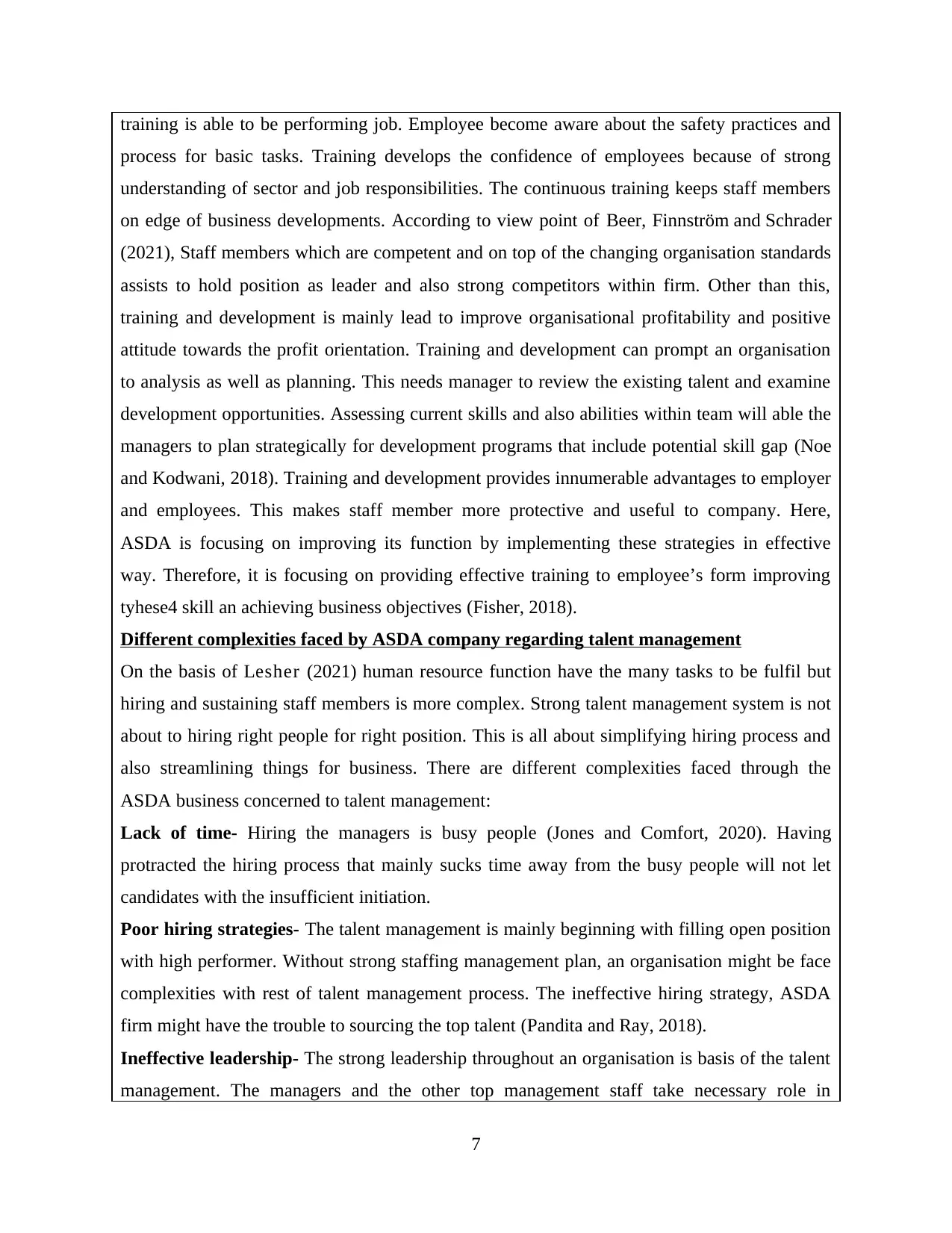
training is able to be performing job. Employee become aware about the safety practices and
process for basic tasks. Training develops the confidence of employees because of strong
understanding of sector and job responsibilities. The continuous training keeps staff members
on edge of business developments. According to view point of Beer, Finnström and Schrader
(2021), Staff members which are competent and on top of the changing organisation standards
assists to hold position as leader and also strong competitors within firm. Other than this,
training and development is mainly lead to improve organisational profitability and positive
attitude towards the profit orientation. Training and development can prompt an organisation
to analysis as well as planning. This needs manager to review the existing talent and examine
development opportunities. Assessing current skills and also abilities within team will able the
managers to plan strategically for development programs that include potential skill gap (Noe
and Kodwani, 2018). Training and development provides innumerable advantages to employer
and employees. This makes staff member more protective and useful to company. Here,
ASDA is focusing on improving its function by implementing these strategies in effective
way. Therefore, it is focusing on providing effective training to employee’s form improving
tyhese4 skill an achieving business objectives (Fisher, 2018).
Different complexities faced by ASDA company regarding talent management
On the basis of Lesher (2021) human resource function have the many tasks to be fulfil but
hiring and sustaining staff members is more complex. Strong talent management system is not
about to hiring right people for right position. This is all about simplifying hiring process and
also streamlining things for business. There are different complexities faced through the
ASDA business concerned to talent management:
Lack of time- Hiring the managers is busy people (Jones and Comfort, 2020). Having
protracted the hiring process that mainly sucks time away from the busy people will not let
candidates with the insufficient initiation.
Poor hiring strategies- The talent management is mainly beginning with filling open position
with high performer. Without strong staffing management plan, an organisation might be face
complexities with rest of talent management process. The ineffective hiring strategy, ASDA
firm might have the trouble to sourcing the top talent (Pandita and Ray, 2018).
Ineffective leadership- The strong leadership throughout an organisation is basis of the talent
management. The managers and the other top management staff take necessary role in
7
process for basic tasks. Training develops the confidence of employees because of strong
understanding of sector and job responsibilities. The continuous training keeps staff members
on edge of business developments. According to view point of Beer, Finnström and Schrader
(2021), Staff members which are competent and on top of the changing organisation standards
assists to hold position as leader and also strong competitors within firm. Other than this,
training and development is mainly lead to improve organisational profitability and positive
attitude towards the profit orientation. Training and development can prompt an organisation
to analysis as well as planning. This needs manager to review the existing talent and examine
development opportunities. Assessing current skills and also abilities within team will able the
managers to plan strategically for development programs that include potential skill gap (Noe
and Kodwani, 2018). Training and development provides innumerable advantages to employer
and employees. This makes staff member more protective and useful to company. Here,
ASDA is focusing on improving its function by implementing these strategies in effective
way. Therefore, it is focusing on providing effective training to employee’s form improving
tyhese4 skill an achieving business objectives (Fisher, 2018).
Different complexities faced by ASDA company regarding talent management
On the basis of Lesher (2021) human resource function have the many tasks to be fulfil but
hiring and sustaining staff members is more complex. Strong talent management system is not
about to hiring right people for right position. This is all about simplifying hiring process and
also streamlining things for business. There are different complexities faced through the
ASDA business concerned to talent management:
Lack of time- Hiring the managers is busy people (Jones and Comfort, 2020). Having
protracted the hiring process that mainly sucks time away from the busy people will not let
candidates with the insufficient initiation.
Poor hiring strategies- The talent management is mainly beginning with filling open position
with high performer. Without strong staffing management plan, an organisation might be face
complexities with rest of talent management process. The ineffective hiring strategy, ASDA
firm might have the trouble to sourcing the top talent (Pandita and Ray, 2018).
Ineffective leadership- The strong leadership throughout an organisation is basis of the talent
management. The managers and the other top management staff take necessary role in
7
Paraphrase This Document
Need a fresh take? Get an instant paraphrase of this document with our AI Paraphraser
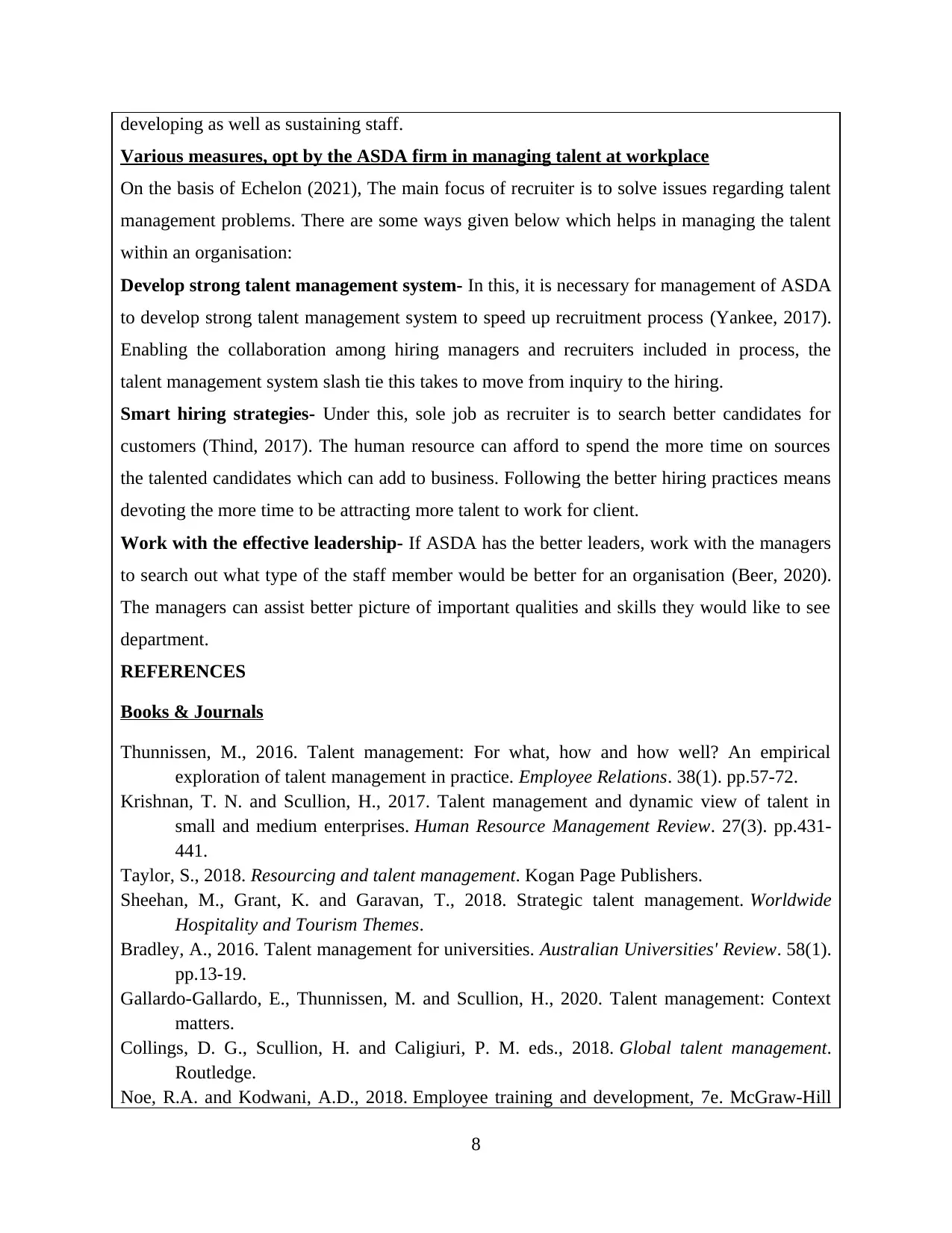
developing as well as sustaining staff.
Various measures, opt by the ASDA firm in managing talent at workplace
On the basis of Echelon (2021), The main focus of recruiter is to solve issues regarding talent
management problems. There are some ways given below which helps in managing the talent
within an organisation:
Develop strong talent management system- In this, it is necessary for management of ASDA
to develop strong talent management system to speed up recruitment process (Yankee, 2017).
Enabling the collaboration among hiring managers and recruiters included in process, the
talent management system slash tie this takes to move from inquiry to the hiring.
Smart hiring strategies- Under this, sole job as recruiter is to search better candidates for
customers (Thind, 2017). The human resource can afford to spend the more time on sources
the talented candidates which can add to business. Following the better hiring practices means
devoting the more time to be attracting more talent to work for client.
Work with the effective leadership- If ASDA has the better leaders, work with the managers
to search out what type of the staff member would be better for an organisation (Beer, 2020).
The managers can assist better picture of important qualities and skills they would like to see
department.
REFERENCES
Books & Journals
Thunnissen, M., 2016. Talent management: For what, how and how well? An empirical
exploration of talent management in practice. Employee Relations. 38(1). pp.57-72.
Krishnan, T. N. and Scullion, H., 2017. Talent management and dynamic view of talent in
small and medium enterprises. Human Resource Management Review. 27(3). pp.431-
441.
Taylor, S., 2018. Resourcing and talent management. Kogan Page Publishers.
Sheehan, M., Grant, K. and Garavan, T., 2018. Strategic talent management. Worldwide
Hospitality and Tourism Themes.
Bradley, A., 2016. Talent management for universities. Australian Universities' Review. 58(1).
pp.13-19.
Gallardo-Gallardo, E., Thunnissen, M. and Scullion, H., 2020. Talent management: Context
matters.
Collings, D. G., Scullion, H. and Caligiuri, P. M. eds., 2018. Global talent management.
Routledge.
Noe, R.A. and Kodwani, A.D., 2018. Employee training and development, 7e. McGraw-Hill
8
Various measures, opt by the ASDA firm in managing talent at workplace
On the basis of Echelon (2021), The main focus of recruiter is to solve issues regarding talent
management problems. There are some ways given below which helps in managing the talent
within an organisation:
Develop strong talent management system- In this, it is necessary for management of ASDA
to develop strong talent management system to speed up recruitment process (Yankee, 2017).
Enabling the collaboration among hiring managers and recruiters included in process, the
talent management system slash tie this takes to move from inquiry to the hiring.
Smart hiring strategies- Under this, sole job as recruiter is to search better candidates for
customers (Thind, 2017). The human resource can afford to spend the more time on sources
the talented candidates which can add to business. Following the better hiring practices means
devoting the more time to be attracting more talent to work for client.
Work with the effective leadership- If ASDA has the better leaders, work with the managers
to search out what type of the staff member would be better for an organisation (Beer, 2020).
The managers can assist better picture of important qualities and skills they would like to see
department.
REFERENCES
Books & Journals
Thunnissen, M., 2016. Talent management: For what, how and how well? An empirical
exploration of talent management in practice. Employee Relations. 38(1). pp.57-72.
Krishnan, T. N. and Scullion, H., 2017. Talent management and dynamic view of talent in
small and medium enterprises. Human Resource Management Review. 27(3). pp.431-
441.
Taylor, S., 2018. Resourcing and talent management. Kogan Page Publishers.
Sheehan, M., Grant, K. and Garavan, T., 2018. Strategic talent management. Worldwide
Hospitality and Tourism Themes.
Bradley, A., 2016. Talent management for universities. Australian Universities' Review. 58(1).
pp.13-19.
Gallardo-Gallardo, E., Thunnissen, M. and Scullion, H., 2020. Talent management: Context
matters.
Collings, D. G., Scullion, H. and Caligiuri, P. M. eds., 2018. Global talent management.
Routledge.
Noe, R.A. and Kodwani, A.D., 2018. Employee training and development, 7e. McGraw-Hill
8
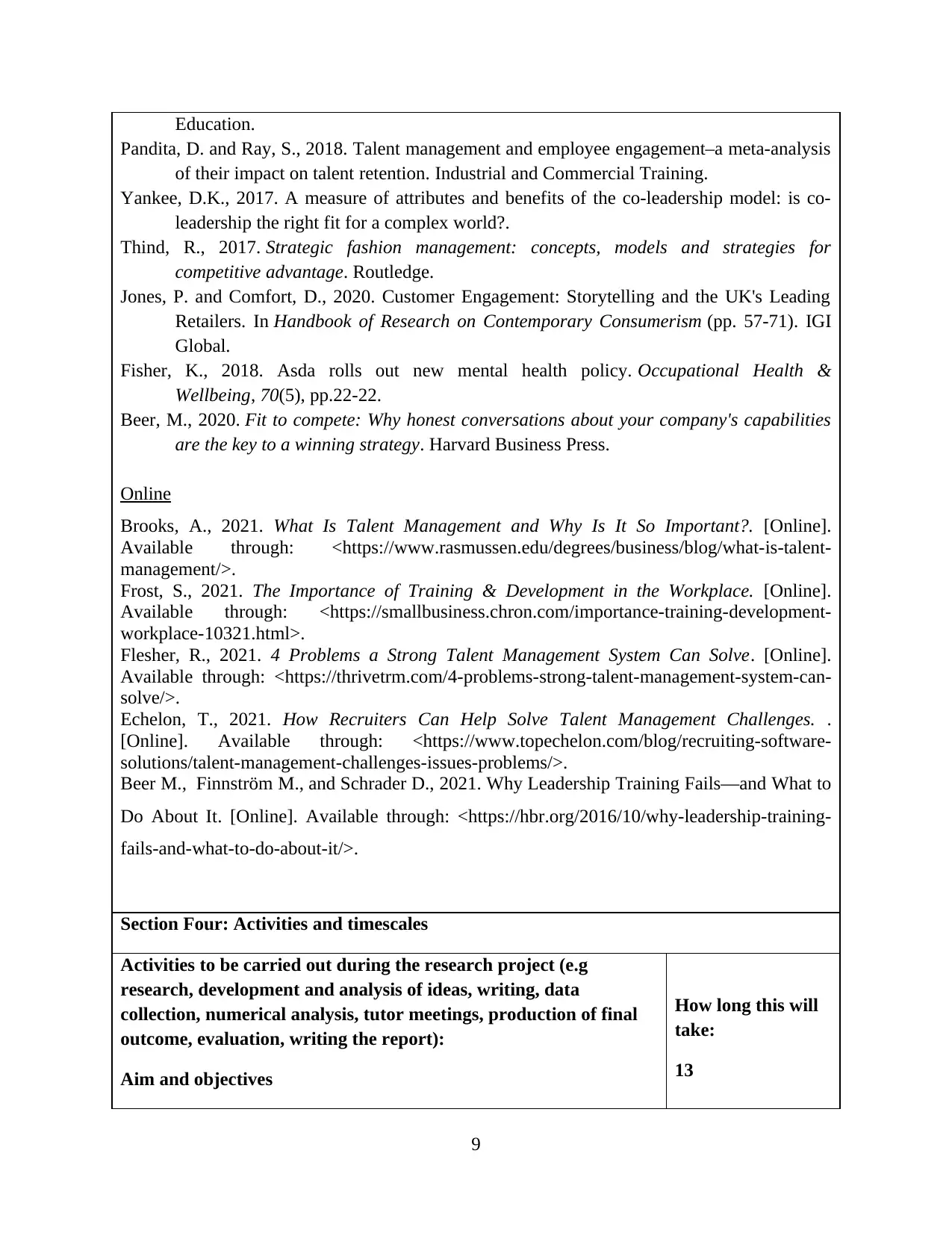
Education.
Pandita, D. and Ray, S., 2018. Talent management and employee engagement–a meta-analysis
of their impact on talent retention. Industrial and Commercial Training.
Yankee, D.K., 2017. A measure of attributes and benefits of the co-leadership model: is co-
leadership the right fit for a complex world?.
Thind, R., 2017. Strategic fashion management: concepts, models and strategies for
competitive advantage. Routledge.
Jones, P. and Comfort, D., 2020. Customer Engagement: Storytelling and the UK's Leading
Retailers. In Handbook of Research on Contemporary Consumerism (pp. 57-71). IGI
Global.
Fisher, K., 2018. Asda rolls out new mental health policy. Occupational Health &
Wellbeing, 70(5), pp.22-22.
Beer, M., 2020. Fit to compete: Why honest conversations about your company's capabilities
are the key to a winning strategy. Harvard Business Press.
Online
Brooks, A., 2021. What Is Talent Management and Why Is It So Important?. [Online].
Available through: <https://www.rasmussen.edu/degrees/business/blog/what-is-talent-
management/>.
Frost, S., 2021. The Importance of Training & Development in the Workplace. [Online].
Available through: <https://smallbusiness.chron.com/importance-training-development-
workplace-10321.html>.
Flesher, R., 2021. 4 Problems a Strong Talent Management System Can Solve. [Online].
Available through: <https://thrivetrm.com/4-problems-strong-talent-management-system-can-
solve/>.
Echelon, T., 2021. How Recruiters Can Help Solve Talent Management Challenges. .
[Online]. Available through: <https://www.topechelon.com/blog/recruiting-software-
solutions/talent-management-challenges-issues-problems/>.
Beer M., Finnström M., and Schrader D., 2021. Why Leadership Training Fails—and What to
Do About It. [Online]. Available through: <https://hbr.org/2016/10/why-leadership-training-
fails-and-what-to-do-about-it/>.
Section Four: Activities and timescales
Activities to be carried out during the research project (e.g
research, development and analysis of ideas, writing, data
collection, numerical analysis, tutor meetings, production of final
outcome, evaluation, writing the report):
Aim and objectives
How long this will
take:
13
9
Pandita, D. and Ray, S., 2018. Talent management and employee engagement–a meta-analysis
of their impact on talent retention. Industrial and Commercial Training.
Yankee, D.K., 2017. A measure of attributes and benefits of the co-leadership model: is co-
leadership the right fit for a complex world?.
Thind, R., 2017. Strategic fashion management: concepts, models and strategies for
competitive advantage. Routledge.
Jones, P. and Comfort, D., 2020. Customer Engagement: Storytelling and the UK's Leading
Retailers. In Handbook of Research on Contemporary Consumerism (pp. 57-71). IGI
Global.
Fisher, K., 2018. Asda rolls out new mental health policy. Occupational Health &
Wellbeing, 70(5), pp.22-22.
Beer, M., 2020. Fit to compete: Why honest conversations about your company's capabilities
are the key to a winning strategy. Harvard Business Press.
Online
Brooks, A., 2021. What Is Talent Management and Why Is It So Important?. [Online].
Available through: <https://www.rasmussen.edu/degrees/business/blog/what-is-talent-
management/>.
Frost, S., 2021. The Importance of Training & Development in the Workplace. [Online].
Available through: <https://smallbusiness.chron.com/importance-training-development-
workplace-10321.html>.
Flesher, R., 2021. 4 Problems a Strong Talent Management System Can Solve. [Online].
Available through: <https://thrivetrm.com/4-problems-strong-talent-management-system-can-
solve/>.
Echelon, T., 2021. How Recruiters Can Help Solve Talent Management Challenges. .
[Online]. Available through: <https://www.topechelon.com/blog/recruiting-software-
solutions/talent-management-challenges-issues-problems/>.
Beer M., Finnström M., and Schrader D., 2021. Why Leadership Training Fails—and What to
Do About It. [Online]. Available through: <https://hbr.org/2016/10/why-leadership-training-
fails-and-what-to-do-about-it/>.
Section Four: Activities and timescales
Activities to be carried out during the research project (e.g
research, development and analysis of ideas, writing, data
collection, numerical analysis, tutor meetings, production of final
outcome, evaluation, writing the report):
Aim and objectives
How long this will
take:
13
9
⊘ This is a preview!⊘
Do you want full access?
Subscribe today to unlock all pages.

Trusted by 1+ million students worldwide
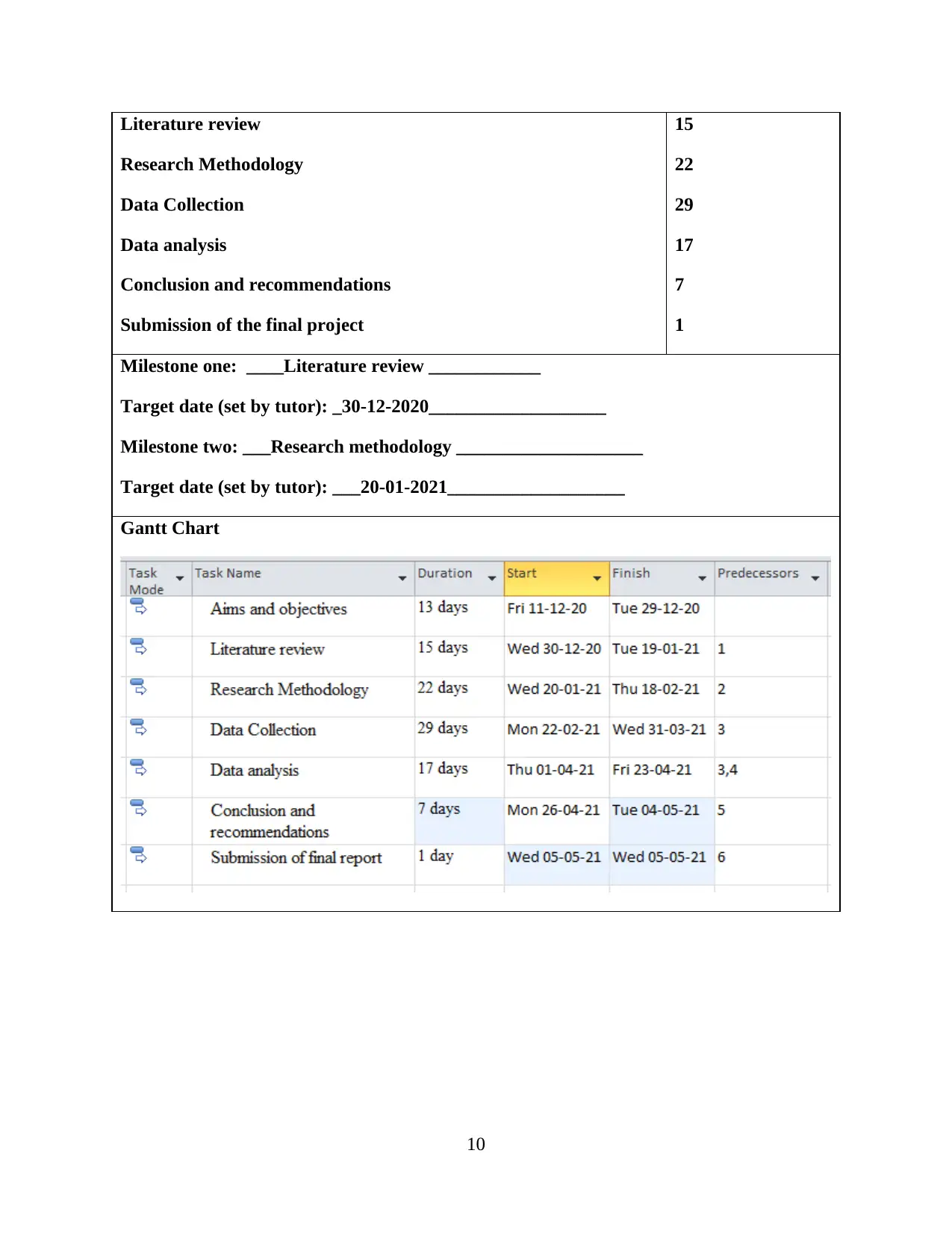
Literature review
Research Methodology
Data Collection
Data analysis
Conclusion and recommendations
Submission of the final project
15
22
29
17
7
1
Milestone one: ____Literature review ____________
Target date (set by tutor): _30-12-2020___________________
Milestone two: ___Research methodology ____________________
Target date (set by tutor): ___20-01-2021___________________
Gantt Chart
10
Research Methodology
Data Collection
Data analysis
Conclusion and recommendations
Submission of the final project
15
22
29
17
7
1
Milestone one: ____Literature review ____________
Target date (set by tutor): _30-12-2020___________________
Milestone two: ___Research methodology ____________________
Target date (set by tutor): ___20-01-2021___________________
Gantt Chart
10
Paraphrase This Document
Need a fresh take? Get an instant paraphrase of this document with our AI Paraphraser
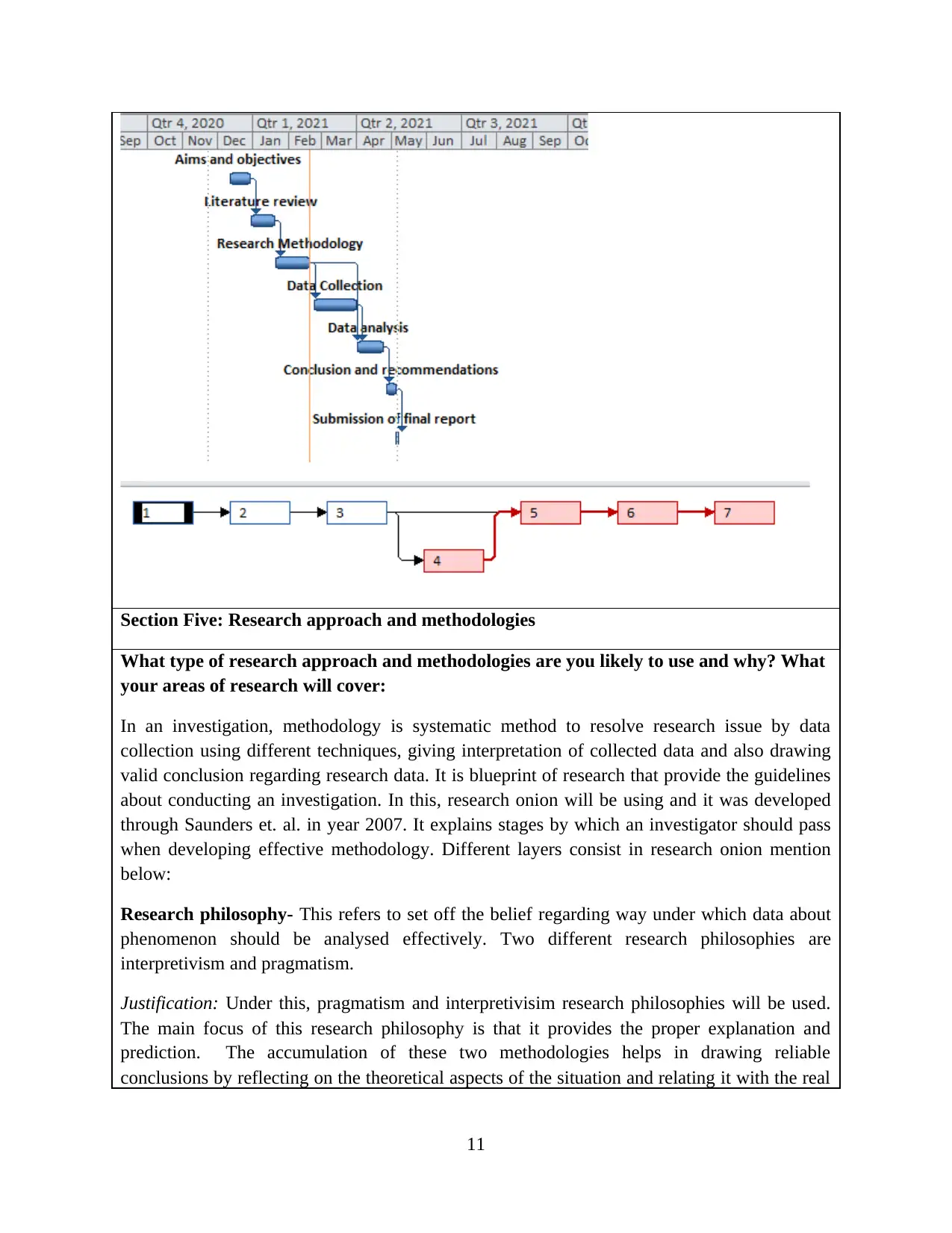
Section Five: Research approach and methodologies
What type of research approach and methodologies are you likely to use and why? What
your areas of research will cover:
In an investigation, methodology is systematic method to resolve research issue by data
collection using different techniques, giving interpretation of collected data and also drawing
valid conclusion regarding research data. It is blueprint of research that provide the guidelines
about conducting an investigation. In this, research onion will be using and it was developed
through Saunders et. al. in year 2007. It explains stages by which an investigator should pass
when developing effective methodology. Different layers consist in research onion mention
below:
Research philosophy- This refers to set off the belief regarding way under which data about
phenomenon should be analysed effectively. Two different research philosophies are
interpretivism and pragmatism.
Justification: Under this, pragmatism and interpretivisim research philosophies will be used.
The main focus of this research philosophy is that it provides the proper explanation and
prediction. The accumulation of these two methodologies helps in drawing reliable
conclusions by reflecting on the theoretical aspects of the situation and relating it with the real
11
What type of research approach and methodologies are you likely to use and why? What
your areas of research will cover:
In an investigation, methodology is systematic method to resolve research issue by data
collection using different techniques, giving interpretation of collected data and also drawing
valid conclusion regarding research data. It is blueprint of research that provide the guidelines
about conducting an investigation. In this, research onion will be using and it was developed
through Saunders et. al. in year 2007. It explains stages by which an investigator should pass
when developing effective methodology. Different layers consist in research onion mention
below:
Research philosophy- This refers to set off the belief regarding way under which data about
phenomenon should be analysed effectively. Two different research philosophies are
interpretivism and pragmatism.
Justification: Under this, pragmatism and interpretivisim research philosophies will be used.
The main focus of this research philosophy is that it provides the proper explanation and
prediction. The accumulation of these two methodologies helps in drawing reliable
conclusions by reflecting on the theoretical aspects of the situation and relating it with the real
11
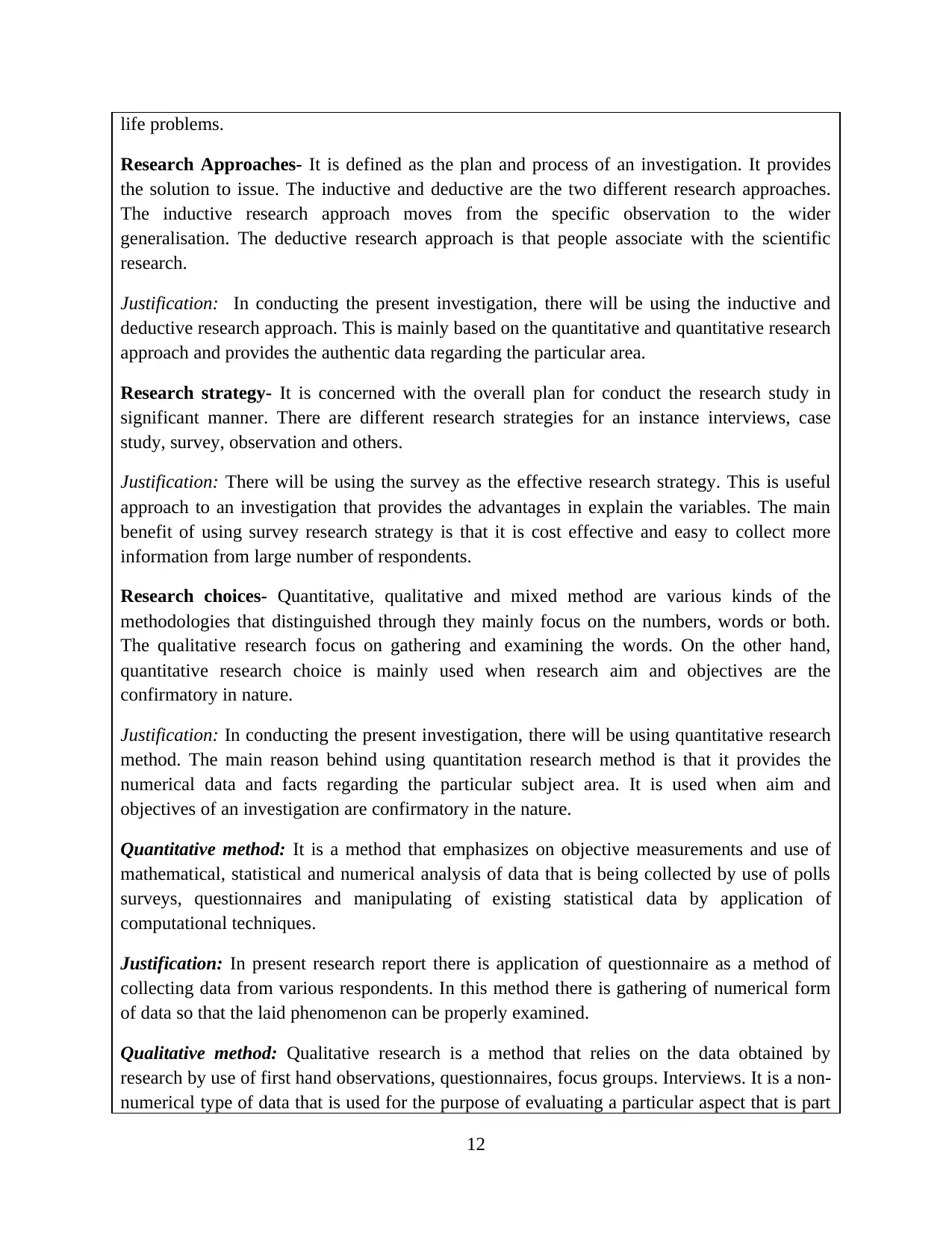
life problems.
Research Approaches- It is defined as the plan and process of an investigation. It provides
the solution to issue. The inductive and deductive are the two different research approaches.
The inductive research approach moves from the specific observation to the wider
generalisation. The deductive research approach is that people associate with the scientific
research.
Justification: In conducting the present investigation, there will be using the inductive and
deductive research approach. This is mainly based on the quantitative and quantitative research
approach and provides the authentic data regarding the particular area.
Research strategy- It is concerned with the overall plan for conduct the research study in
significant manner. There are different research strategies for an instance interviews, case
study, survey, observation and others.
Justification: There will be using the survey as the effective research strategy. This is useful
approach to an investigation that provides the advantages in explain the variables. The main
benefit of using survey research strategy is that it is cost effective and easy to collect more
information from large number of respondents.
Research choices- Quantitative, qualitative and mixed method are various kinds of the
methodologies that distinguished through they mainly focus on the numbers, words or both.
The qualitative research focus on gathering and examining the words. On the other hand,
quantitative research choice is mainly used when research aim and objectives are the
confirmatory in nature.
Justification: In conducting the present investigation, there will be using quantitative research
method. The main reason behind using quantitation research method is that it provides the
numerical data and facts regarding the particular subject area. It is used when aim and
objectives of an investigation are confirmatory in the nature.
Quantitative method: It is a method that emphasizes on objective measurements and use of
mathematical, statistical and numerical analysis of data that is being collected by use of polls
surveys, questionnaires and manipulating of existing statistical data by application of
computational techniques.
Justification: In present research report there is application of questionnaire as a method of
collecting data from various respondents. In this method there is gathering of numerical form
of data so that the laid phenomenon can be properly examined.
Qualitative method: Qualitative research is a method that relies on the data obtained by
research by use of first hand observations, questionnaires, focus groups. Interviews. It is a non-
numerical type of data that is used for the purpose of evaluating a particular aspect that is part
12
Research Approaches- It is defined as the plan and process of an investigation. It provides
the solution to issue. The inductive and deductive are the two different research approaches.
The inductive research approach moves from the specific observation to the wider
generalisation. The deductive research approach is that people associate with the scientific
research.
Justification: In conducting the present investigation, there will be using the inductive and
deductive research approach. This is mainly based on the quantitative and quantitative research
approach and provides the authentic data regarding the particular area.
Research strategy- It is concerned with the overall plan for conduct the research study in
significant manner. There are different research strategies for an instance interviews, case
study, survey, observation and others.
Justification: There will be using the survey as the effective research strategy. This is useful
approach to an investigation that provides the advantages in explain the variables. The main
benefit of using survey research strategy is that it is cost effective and easy to collect more
information from large number of respondents.
Research choices- Quantitative, qualitative and mixed method are various kinds of the
methodologies that distinguished through they mainly focus on the numbers, words or both.
The qualitative research focus on gathering and examining the words. On the other hand,
quantitative research choice is mainly used when research aim and objectives are the
confirmatory in nature.
Justification: In conducting the present investigation, there will be using quantitative research
method. The main reason behind using quantitation research method is that it provides the
numerical data and facts regarding the particular subject area. It is used when aim and
objectives of an investigation are confirmatory in the nature.
Quantitative method: It is a method that emphasizes on objective measurements and use of
mathematical, statistical and numerical analysis of data that is being collected by use of polls
surveys, questionnaires and manipulating of existing statistical data by application of
computational techniques.
Justification: In present research report there is application of questionnaire as a method of
collecting data from various respondents. In this method there is gathering of numerical form
of data so that the laid phenomenon can be properly examined.
Qualitative method: Qualitative research is a method that relies on the data obtained by
research by use of first hand observations, questionnaires, focus groups. Interviews. It is a non-
numerical type of data that is used for the purpose of evaluating a particular aspect that is part
12
⊘ This is a preview!⊘
Do you want full access?
Subscribe today to unlock all pages.

Trusted by 1+ million students worldwide
1 out of 53
Related Documents
Your All-in-One AI-Powered Toolkit for Academic Success.
+13062052269
info@desklib.com
Available 24*7 on WhatsApp / Email
![[object Object]](/_next/static/media/star-bottom.7253800d.svg)
Unlock your academic potential
Copyright © 2020–2025 A2Z Services. All Rights Reserved. Developed and managed by ZUCOL.




